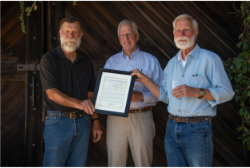Today we turn the blog over to a guest:
Stuart Smith was born and raised in Santa Monica. He founded Smith-Madrone in the high-altitude steep-slope Spring Mountain District AVA in the Napa Valley in 1971. This letter from Stu ran in the May 28, 2024 issue of The Napa Valley Register.

Congressman Mike Thompson came to the winery to present Stu and his brother Charles with a plaque honoring the winery’s 50th anniversary in May, 2021.
I’m very concerned for the future of the Napa Valley wine industry. The wine industry is the very agriculture that the General Plan was written to protect. It states “the highest and best use of land is agriculture:” in other words, wineries and vineyards. Yet three Napa supervisors outright ignore our General Plan.
For the first time ever, our supervisors overturned a staff approved Erosion Control Plan for the Le Colline project by upholding an appeal from the Center For Biological Diversity. Why is this important? The applicants spent over nine years dotting every “I” and crossing every “T” that Napa County asked of them. The applicants reportedly paid close to $2 million to Napa County for them to create an Environmental Impact Report on their project.
At that appeal hearing for the CBD, Planning Director Brian Bordona said he approved the Le Colline Erosion Control Plan, and there would be “no impact” on the environment. Yet Supervisors Ramos, Gallagher and Cottrell rejected their own report and supported the CBD appeal, even though the CBD has a checkered history with the truth.
The supervisors’ votes against Le Colline are unassailably anti-agriculture, as was denigrating their own EIR for justification in supporting the CBD appeal and stopping the Le Colline project. That the supervisors used their own EIR against the applicants that had to pay for that EIR seems to me horribly wrong.
Our supervisors have turned a deaf ear to the needs of the small family winery. No one can deny our wine industry is the economic engine of Napa County and the small family winery is its heartbeat. It is the wine industry that enticed fine dining restaurants, hotels and resorts to open here and thus attract the visitors who provide Napa County with its tax revenues.
I’ve heard from many small winery owners who are deeply afraid of becoming the next target of the county a la Lindsay Hoopes. Both Summit Lake Vineyards and Smith-Madrone Winery tried to support Lindsay Hoopes because we recognized the inherent unfairness of the County’s litigation against her and the chilling effect it’s having on family wineries. That this litigation is over visitation and tasting wine at a decades old “Licensed Winery” and has cost millions is unconscionable. This is a colossal failure of leadership by Napa County. While I believe that the passage of the WDO allowed wineries with a “Use Permit Exemption” to host tours & tastings it’s clear that the 44-year old “Small Winery Use Permit Exemption” is stale, out-of-date and should have been retired and replaced decades ago. Having a “Use Permit Exemption” that prohibits tours and tastings is like owning a sports car with no engine – it’s useless. Additionally, a California O2 license, that all wineries have, grants a winery the right to have customers consume wine on the winery’s premise and prohibits Napa from eliminating that right.
Why is Napa County attacking Lindsay Hoopes when there are dozens of other “Use Permit Exemption” wineries holding daily tours & tastings and Napa County is turning a blind eye to them? Some of the most prestigious wineries in the county are in this group. Selective prosecution of some wineries, but not others, is wrong.
The county should have and I believe still can craft a settlement with Hoopes that would give her and all other “Use Permit exemption” wineries a minimum of say ten visitors per day and then we can all move on from this embarrassment. This should have been done several years ago.
Looking at Napa County’s Winery database, Napa County has allocated 23,000 visitors per day. It’s clear from that list that Napa County favors the largest wineries. 157 wineries, or thirty percent of all Napa wineries, can host zero visitors. The next tranche are 78 wineries that can host an average of seven visitors per day. Yet the largest 55 wineries can host an average of 300 visitors per day for a total of 16,500 which equates to 72% of all visitors to our Valley. One winery gets 2,625 visitors per day.
This allocation of visitors is arbitrary and capricious and is neither fair nor equitable. It does not have to do with infrastructure. We don’t tell folks where to buy their groceries or shop for clothes so why does the County decide where visitors should go and not go? Shouldn’t the visitor be able to go where they want? Is the County intentionally limiting visitors to the small family wineries and thus directing visitors to the larger wineries? Here is another nail by Napa County into the coffin of the small family winery.
Stu Smith
St. Helena
